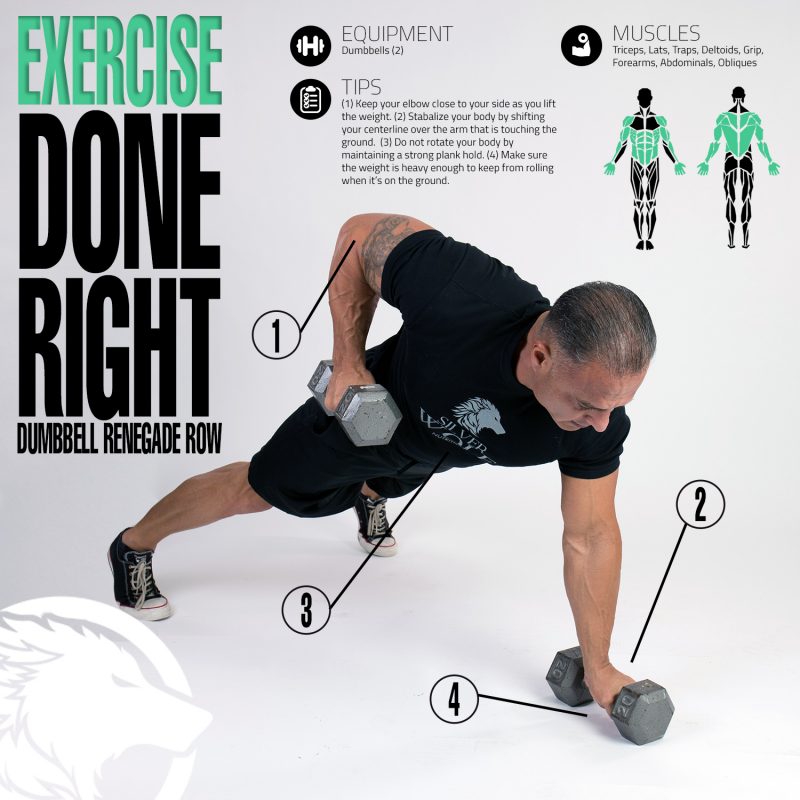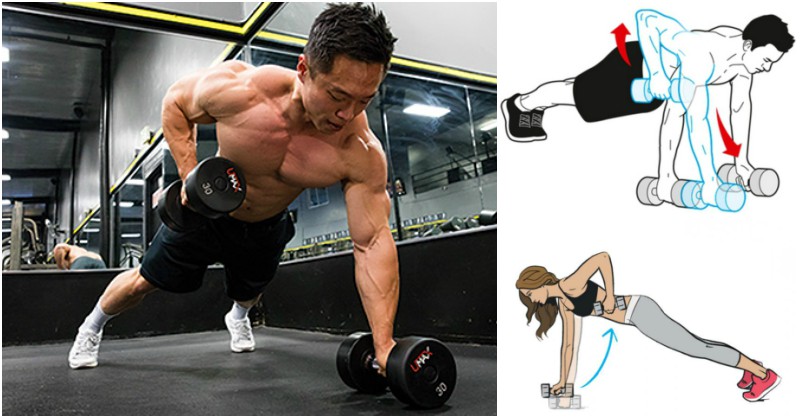The renegade row, extremely beneficial and also a great adaptation on your standard rows. We are all used to the one-arm row, the cable row, upright row, inverted row, and even the bent-over row. But now is the time to try this exercise!
This exercise is a tough compound exercise that strengthens almost all of your upper body. But the best bit, is that it targets the core. This is because whilst elevated, you are forced to hold your posture and position, whilst adding the movement of the dumbbells.
The renegade row effectively highlights any imbalance in the strength of your upper body. You’ll find this if the move is far harder on one side than the other, despite the dumbbells’ equal weights.

6 Benefits of Renegade Rows
- Renegade rows train anti-extension. When you hold proper position without arching your back or pointing your glutes, you’ll work your anterior core to build strength and endurance. Strength combined with the ability to prevent movement when fatigued, is the key to preventing injuries.
- They train anti-rotation. Rotational power is important for athletes, but to build powerful rotation you must first be able to prevent it. With each rep on the renegade row, you’ll need to row slowly while pushing both hands and feet into the ground to prevent movement.
- They hammer your chest, triceps, and shoulders. Your hands are elevated on dumbbells, leading to a deeper push-up. A deeper range of motion means a greater stretch of your muscles, leading to a greater concentric contraction. During each row, you’ll need to push the non-rowing dumbbell into the ground. This creates a strong isometric contraction of your chest, shoulders, and triceps.
- Each set of renegade rows takes 30-60 seconds. Evidence points to time under tension (TUT) being a primary driver for metabolic stress-induced hypertrophy. When done for many sets, the cumulative time under load cooks your upper body and makes for an excellent high-performance finisher.

- They train your lats. You’ll need to row the dumbbell back towards your hip in a “J” pattern. When rowing in this fashion, the lats are the primary focus rather than the traps, rhomboids, and rear delts. Further, your push-up is deeper due to elevating your hands on dumbbells. This hits your lats harder (as well as your chest) as they work overtime to stabilise your shoulders. If you’re not accustomed to deep push-ups, this exercise will create soreness in your lower lats.
- They integrate strength and stability. Your core prevents unnecessary movement and the renegade row strengthens that ability. This protects internal structures, like your spine, from folding like an accordion and setting you up for months of physical therapy.
How To Do A Renegade Row:
- Assume a push-up position with the dumbbells beneath your shoulders and your arms locked out.
- Keep your hips level, not with your glutes up or your back arched.
- Spread your feet a little wider than shoulder width. A wider base aids you in preventing rotation. As you progress, you can bring the feet closer, as long as you’re able to prevent your hips and spine from rotating.
- Perform a full push-up. Tuck your elbows to about 45 degrees, making a “V” shape with your torso and arms.
- After the push-up, row one dumbbell towards your hip while pushing the non-working dumbbell and your toes into the ground. This will serve as a cue to keep your toes from coming off the floor and will help you stabilise and prevent rotation.
- Row slow and prevent your hips from rotating. If you can’t control rotation, you’re using too much weight or going too fast.
- Return the dumbbell to the floor, repeat on the opposite side. That’s one complete rep.

Programming the Renegade Row
There are two times during a workout when you can use renegade rows:
1. Before Workouts as an Extended Warm-up
You can use the renegade row as a “primer” exercise before heavy strength work. Because of the large amount of muscle mass and integrated stability required to do the exercise, you’ll fire up prime movers in your upper body while firing up deep spinal stabilisers.
If you do renegade rows after your warm-up but before heavy strength work, keep the weight light and do 1-2 sets of 5 reps per side. The goal here is to stimulate, not annihilate. If you do too much volume, you could fatigue muscle fibres needed to produce massive amounts of force on the compound lifts you’re about to do. Keep it light and controlled. The goal is priming and stimulation.
2. As a Finisher
At the end of your workout, your primary movers (triceps, chest, shoulders, lats) should be fatigued. Do renegade rows at the end of your workouts and you’ll fatigue the snot out of muscle fibres to increase metabolic stress to drive hypertrophy. Further, your core will work double time to prevent movement while you’re fatigued.
This will teach your body to prevent unwanted motion (and thus, prevent injuries) when they’re most likely to occur – when you’re fatigued. Try 3-4 sets of 5-7 reps with 60-seconds rest at the end of your workout.

